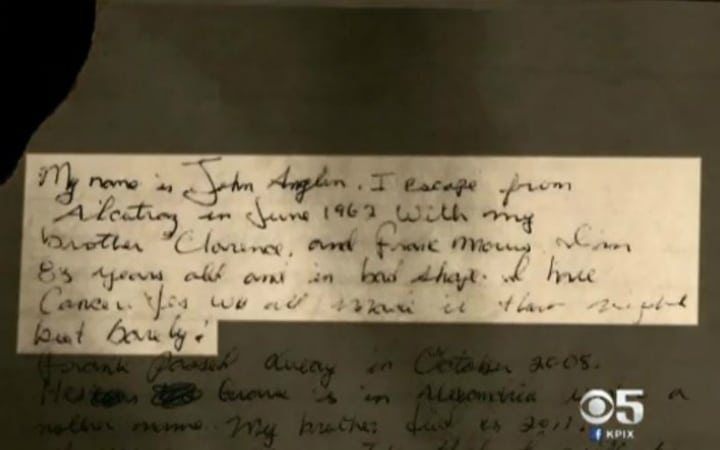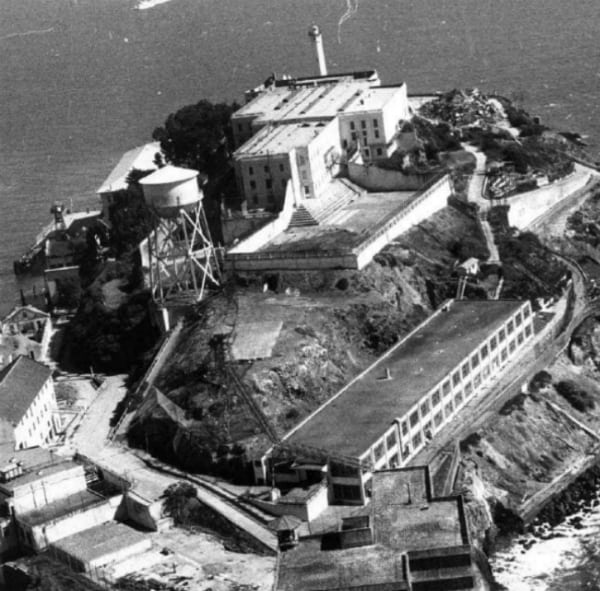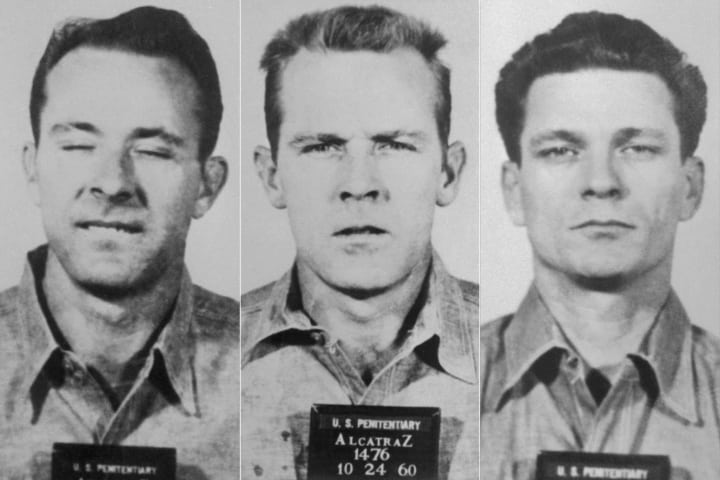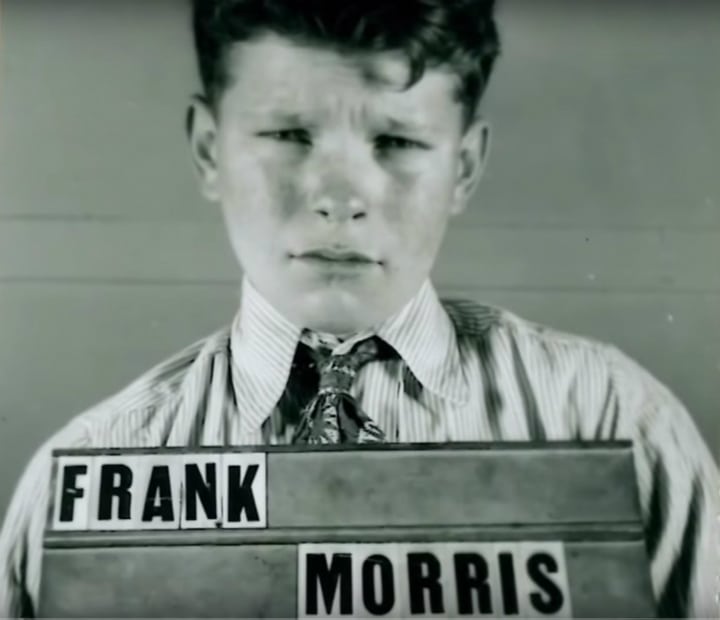

If you've never heard of Alcatraz, you must be dwelling beneath the most oblivious rock. Once, it was the world's ultimate nightmare, an inescapable abyss. No less than 36 souls had futilely dared to flee its clutches. Yet, in a remarkable June day in 1962, history etched an indelible chapter. Three audacious men embarked on a perilous odyssey across the unforgiving San Francisco Bay, determined to defy "The Rock." For over half a century, their fate remained an enigma, until January 2018, when the FBI was compelled to resurrect their quest for answers.
Dive into the riveting details of this seemingly impossible escapade by these three inmates, who dared to defy the unyielding grip of Alcatraz.

In the humdrum routine of the San Francisco Police Department, an ordinary day took an extraordinary turn with the arrival of a cryptic letter. "My name is John Anglin. I escaped from Alcatraz prison in June 1962 with my brother Clarence and Frank Morris," it boldly proclaimed.
The Alcatraz escape had long been an enigma, etching its mystique into American history. Official records declared the trio's demise in the frigid waters, but the letter posed a tantalizing question: Had they fooled the world with an audacious lie, leaving us to wonder if their vanishing act was the greatest prison break in history?

Decades of intrigue shrouded the audacious Alcatraz escape, leaving officials baffled and the world in suspense. Yet, the answers to their enigma lay dormant until a fateful night when a letter arrived, promising revelation. Was it a masterstroke of deception or just an elaborate jest?
In 2013, this cryptic message landed in the hands of the San Francisco Police Department but remained locked in secrecy. The key to unraveling the mystery rested on more evidence, until January 2018 when the Federal Bureau of Investigations finally took the bait, reigniting the quest to unveil the truth behind this mesmerizing vanishing act from the infamous "Rock."

Alcatraz, once the pinnacle of menacing prisons, shuttered its doors in 1963, having meticulously confined society's most infamous villains. The notorious "Rock" was a fortress that held tight to its inmates for 29 long years. But what was the secret behind this seemingly impenetrable maximum-security prison?
Within its formidable walls, Alcatraz boasted the most stringent security measures of its time, a perplexing labyrinth of steel, concrete, and iron will. This intricately planned system ensured that few ever tasted freedom once incarcerated. Step into the shadows of the past, and uncover the enigmatic procedures that made Alcatraz an indomitable fortress, cloaked in history's darkest tales of incarceration.

In the shadow of Alcatraz's grim history, the audacious escape plan unfurled with deceptive simplicity. Yet, its success hinged on a meticulously orchestrated dance of cooperation among inmates. The critical question loomed: What set this plan apart from the scores of previous failures?
Over the years, 23 had been caught, six met their end in a hail of bullets, two were swallowed by the unforgiving waters, and two vanished into the abyss of "missing or presumed drowned." Amid this grim legacy, the masterminds of this escape wove a different narrative, a daring tale that would defy the odds and confound the world.

Locked in adjacent cells on the unforgiving Alcatraz, an unlikely alliance brewed between four formidable minds: the brothers, John and Clarence Anglin, Frank Lee Morris, and Allen West. Time was their ally and enemy, granting them the luxury of crafting a masterful escape plot. Fate had united John and Clarence with Lee Morris from their prior incarceration in Atlanta, and now, within Alcatraz's foreboding walls, they huddled together.
In this crucible of desperation, they'd leverage their collective ingenuity, pooling every resource, and fusing their intellects into an audacious plan that would challenge the very limits of human cunning and resilience.

Frank Lee Morris, a criminal virtuoso, bore a life forged in hardship. Orphaned by age 11, he navigated the turbulent waters of foster care, learning early how to fend for himself. By 13, the law had already ensnared him, but his true destiny lay in the shadows, awaiting discovery.
A prodigious intellect and a cunning mind made him an enigmatic force. As the ringleader of the Great Escape from Alcatraz, Morris would orchestrate a feat that would etch his name into the annals of audacious history. From humble beginnings to the brink of legend, his journey would become the stuff of crime lore, a testament to human tenacity and the allure of the impossible.

Frank Lee Morris, an enigmatic figure, found himself in a whirlwind of incarceration as an adult, consigned to the formidable Louisiana State Penitentiary, known as the "Alcatraz of the South." Yet, the world remained oblivious to the greatness he was destined to achieve. Arrested for a bank heist, he received a 10-year sentence, but Frank was not one to be confined. He broke free, leaving the law confounded.
However, the pursuit of crime led him straight into the jaws of the ultimate prison, Alcatraz. Little did the world know that within its inescapable walls, Frank Lee Morris was about to script a chapter of audacity that would elevate him to the realm of legends.

In the forbidding confines of Alcatraz, Frank Lee Morris assembled a team that would come to be known as "The Rock." Among its ranks were two intriguing brothers, John and Clarence Anglin, and a fellow inmate named Allen West. Hailing from the wandering roots of Georgia, the Anglin brothers had traversed the Southern landscape, their family a clan of nomadic farmers chasing seasonal harvests.
Their annual migration, like clockwork, took them northward in June, a seemingly innocuous routine that would soon become a key piece in the puzzle of their audacious Alcatraz escape. Little did they know, their past would provide the cunning advantage they needed to challenge the prison's unyielding grip.

John and Clarence Anglin, inseparable in childhood, forged an unbreakable bond as they entered adulthood. Cherries were their annual companions, plucking fruit in June, occasionally venturing as far as Michigan. Lake Michigan's waters became their playground, where whispers of their exceptional swimming prowess surfaced. Little did they know, these aquatic escapades would soon play a pivotal role in their fate.
As grown men, the Anglin brothers embarked on a different path, one fraught with crime. The year 1956 saw their first brush with the law, a mere prelude to the audacious exploits that lay ahead. United by blood and shared escapades, the Anglins were destined to etch their names into the annals of outlaw legend.
The Anglin brothers' relentless spirit for freedom did not wane during their stint at the Atlanta Penitentiary, marked by a string of escape attempts that ended in bitter defeat. Their dogged determination earned them a one-way ticket to Alcatraz, the pinnacle of maximum-security prisons. Within its unforgiving walls, they found kindred spirits, notably Frank Lee Morris, the architect of their shared dream.
Alongside Allen West, this formidable quartet hatched an audacious plan, a symphony of brilliance that would transform their lives forever. As the shadows of "The Rock" loomed large, these four souls vowed to defy the odds and inscribe their names into the annals of escape legend.

The quartet's audacious escape plan was underpinned by a unique advantage: Alcatraz was not just a prison; it doubled as a productive factory. While federal inmates elsewhere toiled, "The Rock's" incarcerated craftsmen seized opportunities to gather essential resources. As the prison catered to the U.S. military, it churned out furniture, clothes, and shoes, providing a covert lifeline to the escapees.
Remarkably, these four men's non-violent convictions afforded them a precious reprieve from the relentless scrutiny that imprisoned their peers. They moved in the shadows, free from microscopic surveillance, laying the foundation for a daring gambit that would soon challenge the very essence of Alcatraz's infamy.
With meticulous precision, the daring quartet advanced their audacious plot. Their scheme, a labyrinthine web of complexity and brilliance, was a calculated masterpiece. The goal: a miraculous escape from the formidable Alcatraz.
Their strategy, both ingenious and unnerving, centered on leaving lifelike dummies behind as decoys, a phantom ruse to deceive the ever-watchful guards. The path to freedom demanded they navigate the treacherous labyrinth of prison halls and the treacherous waters surrounding the island, all while avoiding the trigger-happy guards. In this high-stakes game of cat and mouse, the quartet would have to outwit not just the prison, but the very real specter of bullets in their quest to defy the unforgiving confines of Alcatraz.
Each member of the audacious quartet bore a distinct role in their meticulously choreographed escape. A cloak of secrecy shrouded their every move as they prepared for the fateful night. The Anglin brothers, masters of disguise, were entrusted with the task of guarding their dummy surrogates, crafted with an uncanny blend of soap wax, pilfered toilet paper, and human hair swiped from the prison barber shop.
Meanwhile, Frank Lee Morris, the mastermind, took charge of inflating the lifelike vests destined for their empty bunks. As the night drew near, the stage was set, the players poised, and their audacious plot to outsmart Alcatraz in motion, one painstaking detail at a time.

In the depths of Alcatraz, the ingenious quartet embarked on their most perilous endeavor yet: crafting tools for an audacious escape. With cunning resourcefulness, they pilfered spoons from the prison cafeteria and purloined wood from the workshop, forging makeshift picks and screws. Their nightly ritual, from 5:30 PM until the stroke of 9, saw them toiling away in darkness, meticulously chiseling holes to crawl through.
Vent by vent, room by room, they removed the grates, their homemade implements a testament to their audacity. As the holes slowly expanded, so did their chances of eluding the clutches of Alcatraz, with each strike of their makeshift tools echoing defiance against their captors.
The quartet had a hidden ally in their quest for freedom: the crumbling, saltwater-soaked fortress of Alcatraz itself. The relentless saltwater invasion seeped through showers and dishwashers, corroding pipes and saturating prison walls. As the saline intruder infiltrated every nook and cranny, it became an unwitting accomplice in their audacious plan.
But that wasn't all—this unexpected gift brought an unusual warmth. Prisoners accustomed to the chilling waters of the San Francisco Bay were caught off guard by this unanticipated twist. The elements conspired, creating an environment of vulnerability, one that the quartet would exploit in their audacious bid to defy the clutches of Alcatraz.

Amidst the din of Alcatraz's cacophony, one might assume that the quartet's relentless chipping and banging would inevitably arouse suspicion. However, they wielded a brilliant ruse. Prison reforms in the early 1960s gifted inmates a coveted music hour, and chaos ensued as instruments filled the air with melodies and discord.
Frank Lee Morris, in a stroke of genius, mastered the accordion, its resonant tones drowning out their covert escapades. Concealed behind their cells, a utility corridor lay unguarded, housing a network of pipes ascending and descending. It was within this labyrinth of noise and pipes that the quartet orchestrated their escape, their secrets hidden in plain earshot amidst the symphony of Alcatraz's peculiar melodies.
The utility corridor, an unsupervised maze, was their clandestine jungle gym. It held the keys to their ascent through three levels, a daring path to the coveted roof. However, their journey was fraught with surprises. Shockingly, most of the shafts that should have led them to freedom were sealed shut with unforgiving cement.
In a desperate bid, they clung to hope and wielded a simple wrench as their salvation. As it turned out, luck favored the bold. They discovered a lone, unsealed shaft, a narrow portal to the roof. With each twist of the wrench, they inched closer to their destiny, poised on the precipice of an escape that would defy the very essence of Alcatraz's impenetrability.
In the covert shadow of May 1962, the Anglin brothers and Morris, through painstaking determination, had burrowed their way through the unforgiving cell walls. The holes they carved were narrow, barely enough to accommodate their determined escape. Squeezing their bodies through this arduous passage, they knew it was all that was required to attain freedom.
Resourcefulness became their ally as they meticulously crafted lifeboats and vests from 50 raincoats, defying the treacherous cold waters that awaited them. With each stitch, they wove the fabric of their destiny, their escape plot progressing from the realm of audacity into the impending reality of the San Francisco Bay's tumultuous waters.
With each passing day, the intricate puzzle of their escape was falling perfectly into place. Awaiting the finishing touch, Allen West labored tirelessly on his escape hole, poised to unite all four in their audacious bid for freedom. The signal, a harbinger of their imminent departure, was finally received in June 1962. But the unfolding events would shatter their expectations.
On June 11, 1962, Allen West's message rang out, announcing his readiness. Yet, what followed was a shocking twist none had foreseen. Their meticulously plotted escape plan was about to take an unexpected turn, thrusting them into the throes of uncertainty and a high-stakes gamble for their lives.
As the lights dimmed and the world of Alcatraz settled into darkness, the quartet's escape plan surged into motion. The tantalizing dream of life beyond those grim prison walls was a beacon of hope, a siren's call, that beckoned them to risk everything. With hearts ablaze with the thirst for freedom, they stood ready to lay it all on the line.
That fateful night, their eerily lifelike decoys were carefully positioned, while they themselves slipped from their cells into the shrouded labyrinth of Alcatraz, poised on the precipice of an audacious gamble, where the stakes were nothing less than life and liberty.

In the shadowy realm of their escape, the Anglin brothers and Morris navigated the maze with relative ease, slipping from their cells into the inky darkness. But for Allen West, freedom remained tantalizingly out of reach. His miscalculation about the escape hole's size left him wedged, struggling against unyielding cement. Frank Lee Morris strained with relentless determination, yet the unforgiving material refused to budge.
By 9:30 PM, their time ticking away, Morris requested a glass of water. In the grim reality of their predicament, the heartbreaking decision was made—West had to be left behind, the ultimate sacrifice in their audacious bid for freedom from the inescapable clutches of Alcatraz.
The heart-wrenching decision to leave Allen West behind weighed heavy on the trio's shoulders, a bitter choice forged by the cruel hand of circumstance. Months of meticulous planning, camaraderie, and shared dreams now hung in the balance. But their options were stark; widening West's hole would risk discovery, jeopardizing their entire escape. There was a silver lining, though, as their raft would now bear less weight, making the treacherous journey ahead marginally less perilous.
Their next challenge loomed: a daunting 30-foot ascent to reach the utility box. In this crucible of choice and circumstance, their fate teetered on a knife's edge, one step closer to either freedom or retribution within the unforgiving realm of Alcatraz.
With hearts pounding and adrenaline coursing through their veins, Morris and the Anglin brothers swiftly ascended to the rooftop, covering a harrowing 100 feet in dizzying haste. It was a breathless race against time and discovery. Their descent brought them to the precipice of a 50-foot pipe, a lifeline down the building's side. Clinging to this makeshift conduit, they slowly lowered themselves to solid ground, just a stone's throw from the watchful eyes of the shower area guards.
Like phantoms in the night, they outwitted their captors, slipping away towards the moonlit shore. There, their escape plot hung in the balance, dependent on inflating their raft and life vests, their audacious journey poised on the precipice of triumph or capture.

As the moon hung high in the midnight sky, Frank Lee Morris and the enigmatic Anglin brothers set sail on their makeshift raft, disappearing into the inky blackness of the San Francisco Bay. It was an audacious act of defiance, their final vanishing act.
It wasn't until the early hours of the morning that the prison's chilling realization struck like a bolt of lightning. The deafening sirens pierced the night, rousing the inmates from their slumber. In the hallowed halls of "The Rock," an unprecedented escape had confounded all, leaving a bewildered prison in its wake. The impossible had become a reality, as the trio had defied the seemingly impenetrable fortress and slipped away into history's shadow.
Allen West, no stranger to determination, refused to succumb to despair. With relentless resolve, he toiled to expand his escape hole until it was just wide enough to squeeze through. Victory surged through his veins as he broke free from his cell's grip. Yet, when he reached the rooftop, the chilling reality struck like a hammer blow—his comrades had vanished into the night.
Now standing alone on the precipice of freedom, West faced a heart-wrenching choice: return to his cell, a prisoner once more, or embrace the treacherous waters of the San Francisco Bay, where peril and possibility coalesced into an uncertain and audacious gamble for his life.
With a heavy heart, Allen West chose the path of caution, returning to his cell as the morning sun painted the prison in an eerie light. The news of their audacious escape had spread like wildfire, setting off a frenzied manhunt.
Cooperation with the authorities hung like a question mark over West's head. As alarms blared, and the net of scrutiny tightened, he spilled the beans on their daring plan. Angel Island beckoned as their first destination—a haven for stolen cars, pilfered clothing, and an uncertain future. But in the fog of uncertainty, whether West spoke the unvarnished truth or played another card in the game of audacity remained a tantalizing mystery.
As the hours ticked by, a vexing problem unfolded: there had been no reported car thefts or clothing heists within the critical 12-hour window after the trio's escape. The chilling possibility hung in the air, like an unanswered riddle—had Morris and the Anglin brothers reached an alternative destination, or had fate taken a far grimmer turn?
Adding another layer of intrigue, Allen West boldly claimed to be the mastermind behind the audacious escape, positioning himself as the architect of their Houdini-like feat. As the mystery deepened, the FBI was summoned, their seasoned investigators tasked with unraveling the enigma of the three elusive souls who had vanished from the heart of Alcatraz.
As the sun rose on the following day, a mystifying absence lingered—the bay waters yielded no bodies, no trace of Morris and the Anglin brothers. Instead, a perplexing discovery unfurled: personal belongings, silent witnesses to an enigmatic escape.
The chilling waters of the San Francisco Bay, notorious for their frigidity, gnashed at a temperature of 50 to 54 degrees. Here, the inexorable embrace of cold would assail an adult man's bodily functions within a mere 20 minutes. An unsettling truth emerged—the inmates, accustomed to the prison's warm confines, faced an unforgiving adversary in the icy waters, leaving the ultimate fate of their audacious escape veiled in a shroud of chilling uncertainty.
A month after the audacious escape, hope flickered with the discovery of a floating body, found 17 miles from the iconic Golden Gate Bridge, clad in attire reminiscent of Alcatraz prisoners. Yet, this glimmer of potential closure was lost in the labyrinth of time, as the report reached the world too late. An exhaustive, years-long investigation ensued, a relentless quest to unravel the enigma of their disappearance.
The final chapter in this chilling tale was etched on December 31, 1979, a staggering 17 years after their escape. With heavy hearts and aching uncertainty, the FBI drew its somber conclusion: Morris and the Anglin brothers had succumbed to the relentless embrace of the San Francisco Bay's icy waters, their fate forever bound to the enigmatic waters they sought to conquer.
In a stunning twist, the History Channel's 2015 documentary shattered the established narrative, asserting that the Anglin brothers had, against all odds, managed a triumphant escape from Alcatraz. Evidence began to surface, igniting hope where once there was only mystery. Christmas cards bearing their unmistakable handwriting found their way to their family, a haunting echo of their existence.
A photograph, captured in Brazil in 1975, further fueled the intrigue. Forensic experts, while cautious, deemed it "more than likely" to be John and Clarence Anglin. As the tendrils of evidence continued to weave a tantalizing web, the Alcatraz escape mystery refused to rest, leaving the world to grapple with the enigmatic fate of these audacious fugitives.
A staggering revelation emerged from the depths of secrecy as one of the Anglin siblings, Robert, breathed his final words on his deathbed. With the weight of the family's most closely-guarded secret pressing on his conscience, he confessed to maintaining clandestine contact with John and Clarence for an astounding 24 years, spanning from 1963 to 1987. Yet, like a story shrouded in shadows, the connection mysteriously dissolved.
Haunted by the specter of an Interpol investigation that still hung over their family, members were left with an agonizing truth—their quest for closure and answers remained locked away, as the echoes of the Alcatraz escape continued to reverberate through the corridors of time, an enduring enigma of audacity and secrecy.

In a jaw-dropping twist, the 2013 letter, purportedly from John Anglin, thrust the Alcatraz mystery back into the spotlight. Confirmed and debunked a multitude of rumors that had swirled for decades. In startling candor, John's words revealed, "Yes, we all made it that night but barely! … I'm 83 years old and in bad shape. I have cancer."
The echoes of their audacious escape shattered the silence. Frank's haunting fate was unveiled—his grave, a hidden enigma, nestled in Argentina under an alias, since October 2008. Then, a chilling revelation—he disclosed his own post-Alcatraz existence, spent in the unsuspecting realms of Minot, North Dakota, and Fargo, a shocking epilogue to a saga steeped in mystery and audacity.

The letter's cryptic conclusion hung in the air like a thunderclap—"Living in Southern California now." Could it be that the elusive fugitive had been dwelling just a stone's throw from the very city he had once dared to defy? John Anglin, the enigmatic scribe, now lay on a sickbed, his defiance unabated, unburdened by the specter of returning to jail.
In a bizarre twist, the missive bore an unusual request, a plea to an unconventional law enforcement—should they come forward with a simple message, John Anglin promised to turn himself in, an offer that dangled like a tantalizing thread, threatening to unravel a web of intrigue that had endured for decades.
Amidst the intrigue of the letter, a staggering proposition unfurled—"If you announce on TV that I will be promised to first go to jail for no more than a year and get medical attention, I will write back to let you know exactly where I am. This is no joke…" The audacious plea hung in the balance, its veracity and intent shrouded in mystery.
Before any pact could be forged, the wheels of law enforcement sprang into motion, embarking on a meticulous investigation of the letter's cryptic contents. With bated breath, they scrutinized each word, each nuance, in a relentless quest for clues, unraveling a puzzle that promised either resolution or the elusive specter of Alcatraz's enduring enigma.

As the letter underwent the crucible of scrutiny, the FBI's forensic wizards swung into action, subjecting it to a battery of tests, a quest for that elusive nugget of truth. DNA analysis, like a silent witness, held the promise of revelation. And the results? A bombshell dropped courtesy of San Francisco's KPIX—"the FBI's results were inconclusive."
In the twilight zone of uncertainty, the line between affirmation and denial blurred, leaving everything in a disconcerting limbo. The authenticity of the letter, a tantalizing enigma, swung precariously between "yes" and "no," a riddle that defied resolution, ensuring the enduring mystique of the Alcatraz escape continued to confound even the most relentless investigators.

In the swirling haze of uncertainty, the U.S. Marshals Service ventured into the realm of possibility, hinting that the audacious escapees may have indeed lived on beyond the prison walls. Yet, the enigmatic letter, published in January 2018, cast a shadow of doubt. A representative from the Service, in a bombshell revelation to The Washington Post, labeled the letter as illegitimate.
Amidst this perplexing landscape, the Marshals Service pledged to relentlessly pursue leads, an unwavering quest that would persist until the men either reached the ripe age of 99 or their demise was incontrovertibly established. For the FBI, the case had long been sealed in 1979, declaring, "No credible evidence emerged," an assertion that shrouded the Alcatraz enigma in an enduring cloak of intrigue.

When the enigmatic letter surfaced, unveiled to the public by a shadowy source through San Francisco's KPIX, it thrust the Alcatraz mystery back into the spotlight. Yet, the U.S. Marshals, guardians of the relentless pursuit of justice, cast a stark shadow of skepticism. In a statement that reverberated through the corridors of uncertainty, they opined, "There is no reason to believe that any of them would have changed their lifestyle and became completely law-abiding citizens after this escape."
In this gripping narrative, the U.S. Marshals' unwavering resolve to keep the investigation alive loomed large, a testament to the enduring fascination and elusiveness of the Alcatraz escape, where fact and legend intertwined in an enigmatic dance.
The three prisoners would have a good chance of surviving if they were released at midnight, according to a computer model used by a study team in 2014. What happened that evening?
Deputy US Marshal Michael Dyke said, "There's an active warrant, and the Marshals Service doesn't give up looking for people," in 2009. Another piece of information was made public.

In March 2018, Jim Albright, the last guard of Alcatraz, shared captivating insights with San Francisco's ABC 7 on the 55th anniversary of the prison's closure. When asked about the infamous escape, Albright offered a unique perspective. "It depends on whether you're talking to me or their mother," he mused.
With a solemn tone, he firmly believed that the escapees had met their demise in the icy waters surrounding the island. Yet, Albright speculated that the enigmatic letter-writer, seeking attention for his cancer treatment, might be breathing new life into the mystery. Alcatraz, a place of legends and secrets, continues to intrigue.

The enigma of Frank Lee Morris, John Anglin, and Clarence Anglin endures, shrouding their Alcatraz escape in an enduring cloak of uncertainty. Decades have passed since they vanished into the inky San Francisco Bay waters, leaving the world to wonder if they survived or succumbed to the treacherous currents.
The cryptic 2013 letter, its author still a phantom, adds a tantalizing layer to this enigma, leaving us on the edge of our seats. Now, aged 90, Frank Morris, and his cohorts John and Clarence Anglin, aged 86 and 87 respectively, would have to serve just ten more years, but the question remains: do they still walk among us, old and gnarled, or did the frigid waters of Alcatraz forever conceal their fate? The mystery endures, a testament to the allure of the inexplicable.